#a staple bread in my country
Explore tagged Tumblr posts
Text
thinking of naming the puter desal
#txt#objectum#since i'm falling in love with it…#it has multiple meanings#one it's derived from 'pandesal'#a staple bread in my country#(also one of my fav breads in general)#two it's one letter away from the word 'dasal'#meaning 'prayer'#and three (i only realized this just now) it's pronounced similarly to 'that's all' FJJWQQSWJASQJ#i'm a little saddened that after having this computer all these years#never once i thought of naming it (according to my memory at least)#oh well. netter late than never#i'm prolly just gonna call it 'desa' when i feel like i've settled#since that one feels more computer-y to me
1 note
·
View note
Text
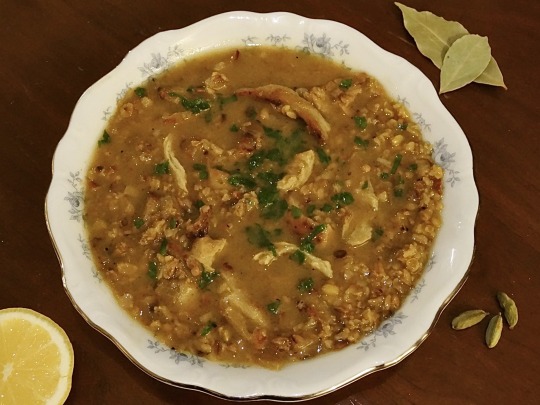
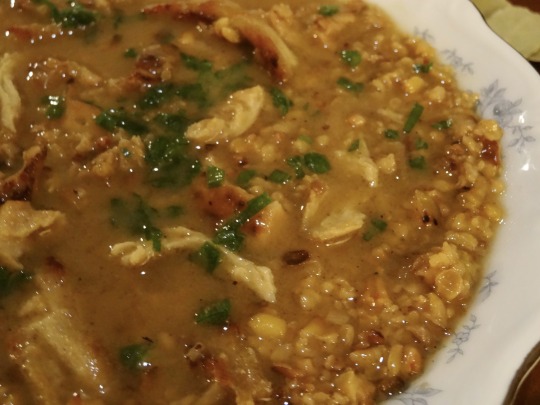
[ID: A greenish-brown soup with an herb garnish in a bowl surrounded by a halved lemon, green cardamom pods, and bay leaves, followed by a close-up of the same soup. End ID]
شوربة الفريكة / Shorabat al-frika (Green wheat soup)
Frika (فَرِيكَة or فَرِيك; also transliterated "freekeh," "frikeh," or "farik") is durum wheat harvested in the early spring, while the grain is green, unripe, and tender. Durum wheat, or semolina, is a different species of wheat than that which is ground to produce all-purpose flour (common wheat, or bread wheat); it is used to make couscous (كُسْكُس), bulghur (بلغور), and many types of pasta, and is widely consumed in North Africa, the Levant, and the Arabian peninsula. After harvest, unripe durum is sun-dried and then set ablaze in piles to burn off the straw and leave just the heads of wheat, resulting in a nutty, smoky flavor; the heads are then vigorously rubbed, traditionally by hand, to remove the bran. Frika is named after this last process; the word comes from the verb "فَرَكَ" "faraka," "to rub."
A staple in Palestine, shorabat al-frika (with diacritics, Levantine pronunciation: شُورَبَة الفْرِيكَة) is often eaten as an appetizer with the fast-breaking meal during Ramadan. It may contain nothing more than an onion, olive oil, frika, and water, but sometimes contains meat (usually chicken, but also beef or lamb), green chili peppers, and spices including cardamom, black pepper, bay leaves, turmeric, cumin, and seb'a baharat; some people today like to add chickpeas. Shorabat al-frika is often prepared with the chicken broth obtained by boiling chicken to make musakhkhan (مُسَخَّن), and served alongside it. It is a warming, filling, and earthy soup, with a complexity of flavor imparted by the frika itself: a fresh tartness due to the unripe grain, and a roasted aroma due to its harvesting process.
Shorabat al-frika is in keeping with a Palestinian food ethos of using simple, local ingredients to their fullest potential. Frika itself is sometimes thought to symbolize adaptability and resilience, as it was often eaten in times of scarcity when other crops were not yet ready to be harvested. Legend holds that it was discovered in a time of similar necessity: when villagers in the eastern Mediterannean tried to salvage a field of wheat that had been burned by ambushing soldiers, they found that the grain was still edible beneath the blackened chaff, having been saved from the fire by its moisture.
Frika, due to its centuries as a staple in Palestine, has also come to symbolize acceptance, Palestinian history, and connection to the land and community. In the Palestinian diaspora and amongst internally displaced people in Palestine, food is conceived of as a form of connection to homeland across distance; continuing to make Palestinian food, and remembering or using baladi ("native," "from my country") varieties of grains, produce, and herbs, is a link to the land and an expression of the hope to return.
By the same token, though, frika has come to represent Palestinian displacement and "cultural obliteration," per Rana Abdulla. One of the ways in which Israel rhetorically justifies its existence is by claiming sole ownership of an old, organically arising culture rooted in the land: the easiest way to do this is, of course, to rebrand what was already there. Food connects and combines language (in terminology and pronunciation), culture, history, climate, and land into one web of discourses, and is therefore a prime site for colonial myth-making and ideological nation-building. Thus a construction such as "Israeli freekeh" is, in fact, an intensely political one.
Nevertheless, frika continues its life as a symbol of connection, community, and resistance during adversity in Palestine. Nasser Abufarha, of the Palestine Fair Trade Association, noted in 2015 that more and more Palestinians across the West Bank were harvesting some of their wheat early to make frika, rather than relying on cheaper, imported rice. As of October 23 2023, and in defiance of an Israeli air raid which destroyed their kitchen in 2014, Jamil Abu Assi and his cousins were using frika, alongside lentils and rice, as staples in distributing food to thousands of refugees per day in Bani Suhaila, near Khan Younis. Others in the community donated ingredients or volunteered to distribute meals.
Support Palestinian resistance by contributing to Palestine Action's bail fund or to Palestine Legal's defence fund, or by attending court or making a sign to support the Elbit Eight.
Ingredients:
1 cup (170g) frika baladia (فريكة بلدية), Levantine frika
4 cups water, or vegetarian chicken stock from concentrate
1 large yellow onion, chopped
1/4 cup extra virgin olive oil
1 green chili pepper (فلفل أخضر حار), sliced (optional)
1/2 tsp ground black pepper (فلفل اسود)
5 cardamom pods (حب هال)
2 Mediterannean bay leaves (ورق غار)
250g chicken (or beef) substitute, torn or cubed (optional)
Salt, to taste
Parsley, to garnish
Halved lemon, to serve (optional)
I have kept the spices relatively simple, as most cooks do, to highlight the earthy end of the taste spectrum and to allow the flavor of the frika itself to come forward. Most people add at least cardamom and black pepper; many add bay leaves to this duo; turmeric is the next most common addition I have come across. I have seen a few people add cumin, coriander, or allspice.
Frika can be found in the grains section of your local halal grocery store (labelled "فريكة", “فريك" "freekeh" or "frikeh"). Look for something that specifies “roasted.”

You may also be able to find frika at a speciality or health foods grocery store, but it might not have been fire-roasted as it is in the Levant. If your frika doesn't smell toasty, try roasting it in a dry pan on medium-heat for a few minutes until fragrant.
Frika may be found whole, cracked, or fine (نَاعِمَة / na'ima). You may use any kind for this soup; most people use cracked or fine frika, because of its shorter cooking time. You can pulse whole frika a few times in a food processor or spice mill, until coarsely ground, if you prefer a fine texture but can't find fine frika.
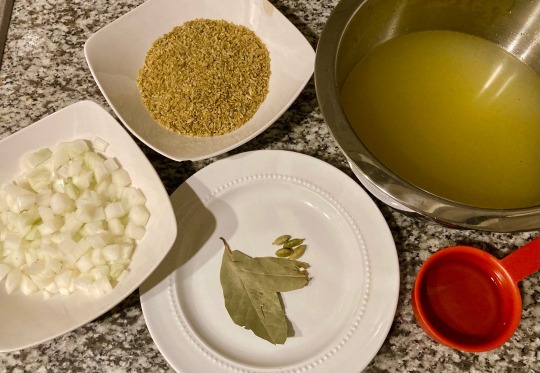
Instructions:
1. Heat olive oil in a large pot on medium. Add onion, a pinch of salt, cardamom pods, and bay leaves and fry, stirring occasionally, until the onion is golden brown.
2. Add the chili pepper and cook briefly until softened.
3. Add frika and black pepper and roast, stirring occasionally, for a few minutes until fragrant.
4. Add the water or stock and stir to combine. Bring to a fast simmer and cook, covered, about 50 minutes for whole frika and 20 minutes for ground, until fully cooked. Add additional water as necessary. The frika will still be chewy at the end of the cooking time.
5. Fry meat substitute of your choice in olive oil with salt, black pepper, and a optionally a pinch of Palestinian seven-spice, until browned. Add to soup and stir to combine. Taste the soup and add salt and more black pepper, if necessary.
6. Garnish with whole or chopped parsley and serve warm.
The meat is usually added to this soup just after the onions, and simmered along with the frika. You can do it this way if you like, but I have never found simmering to do the texture of meat substitutes any favors.
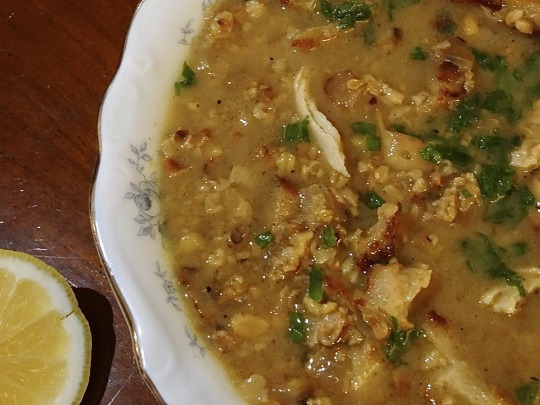
497 notes
·
View notes
Text
Jonathan's Food Blog
I've decided to write down all the foods mentioned in Dracula. I think it could be fun. Below are all the foods, as well as how they are described in the book and (if I can) a link to a recipe and/or further information 😊 May 3rd - Jonathan Harker's Journal
Paprika Hendl - Perhaps the most famous dish of all. "I had for dinner, or rather supper, a chicken done up some way with red pepper, which was very good but thirsty. (Mem., get recipe for Mina.) I asked the waiter, and he said it was called “paprika hendl,” and that, as it was a national dish, I should be able to get it anywhere along the Carpathians. " Recipe for Paprika Hendl (Paprikás Csirke)
Mamaliga and Impletata - "I had for breakfast more paprika, and a sort of porridge of maize flour which they said was “mamaliga,” and egg-plant stuffed with forcemeat, a very excellent dish, which they call “impletata.”"
Recipe for Mamaliga
Recipe for Impletata
May 5th - Jonathan Harker's Journal
"Robber Steak" and Golden Mediasch - "lest who reads them may fancy that I dined too well before I left Bistritz, let me put down my dinner exactly. I dined on what they called “robber steak”—bits of bacon, onion, and beef, seasoned with red pepper, and strung on sticks and roasted over the fire, in the simple style of the London cat’s meat! The wine was Golden Mediasch, which produces a queer sting on the tongue, which is, however, not disagreeable. I had only a couple of glasses of this, and nothing else." Slivovitz - "There is a flask of slivovitz (the plum brandy of the country) underneath the seat, if you should require it." Recipe for Robber Steak
Golden Mediasch - Bram Stoker likely read about Mediasch wine in the detailed travel book by British author Charles Boner, TRANSYLVANIA. ITS PRODUCTS AND ITS PEOPLE. In this book, there is an extensive chapter all about wines in Transylvania. There are even records of Stoker's library loaning of this book to him, likely studying it while doing his research for the novel.
Although Golden Mediasch is no longer produced, pairing your robber steak with a sweet, dry white wine, like a German Riesling, will probably do the trick. Slivovitz - Slivovitz is a plum brandy popular throughout eastern Europe and not entirely unlike Italian grappa.
Roast Chicken and Tokay - "The Count himself came forward and took off the cover of a dish, and I fell to at once on an excellent roast chicken. This, with some cheese and a salad and a bottle of old Tokay, of which I had two glasses, was my supper." Recipe for Roast Chicken Tokay - Tokaji or Tokay is the name of the wines from the Tokaj wine region (also Tokaj-Hegyalja wine region or Tokaj-Hegyalja) in Hungary or the adjoining Tokaj wine region in Slovakia. This region is noted for its sweet wines made from grapes affected by noble rot, a style of wine which has a long history in this region.
May 7th - Jonathan Harker's Journal
Cold Breakfast with Coffee - "When I had dressed myself I went into the room where we had supped, and found a cold breakfast laid out, with coffee kept hot by the pot being placed on the hearth ... I set to and enjoyed a hearty meal."
Cold Breakfast - In the late 19th century, a “cold breakfast” in the regions of Hungary and Romania would have comprised a selection of preserved and readily available foods.
A traditional cold breakfast during this period likely included:
• Cold Cuts: Varieties of cured meats such as salami, pastrami, and smoked sausages were common. These meats were often homemade and preserved through smoking or curing, making them suitable for cold service .
• Cheeses: Cheeses like telemea, a brined cheese similar to feta, made from cow or sheep milk, were staples. These cheeses were often produced locally and served sliced or crumbled .
• Bread and Pastries: Freshly baked bread was a daily essential, often accompanied by homemade jams or honey. In some regions, pastries such as kürtőskalács (chimney cake) were enjoyed, though these were more commonly associated with festive occasions .
• Fresh Vegetables and Fruits: Seasonal produce like tomatoes, cucumbers, and capsicum (where we also get our beloved paprika!) were sliced and served alongside the main items. Fruits such as apples, plums, and cherries were also common, either fresh or preserved .
• Dairy Products: Yogurt and sour cream were frequently included.
Coffee - Coffee held a significant place in Hungarian and Romanian culture, influenced heavily by Ottoman traditions. Introduced to Hungary in the 16th century during Ottoman occupation, coffee became deeply ingrained in the social fabric.
In the 19th century, the prevalent method of coffee preparation was similar to Turkish coffee: Finely ground coffee beans were combined with water (and sometimes sugar) in a small pot, then brought to a boil. This method produced a strong, unfiltered coffee, often served in small cups.
38 notes
·
View notes
Note
Wait, Rollo calls it pain au chocolat. Do you think some people *cough* Rook *cough* bother him by calling the bread choclatine? 😂
(If you don’t know what i mean, look up the great debate on pain au chocolat vs. choclatine)
I do have Rook's mother being from the south of Fleur (France) so it mostly checks out XD
Its just how he learned to say it.
🔔: Yes, crossaints are a staple of the country's breads, though I truly prefer pain au chocolat more-
🎯: Ah! Chocolatines! My grandmother makes them fresh whenever we come to visit her in the summer.
🔔:
🔔: *Glares and covers his mouth*
#twisted wonderland#twst#disney twst#twst wonderland#rollo flamme#rook hunt#glorious masquerade#valcorrectquotes#valencia rambles
65 notes
·
View notes
Text
There can never be too many tomatoes. August’s heat is always made more bearable for me by peak tomato season. I love to eat them cut into thick rounds and topped on crusty well-buttered toasted bread, or chopped small in a simple Israeli salad alongside cucumber and herbs. By this time of year, I end up with way more tomatoes from the garden and the market than I could possibly use up in sandwiches and salads alone. I’ll use the extra tomatoes to make sauce, but I also like to find a few more creative ways to take advantage of the bounty of summer.
Stuffed vegetables of all kinds were regularly made and eaten in our home, just as they are in many other Russian Jewish kitchens. Stuffed cabbage, stuffed peppers, and stuffed mushrooms are regional staples. As I’ve explored and learned to cook the food of the former Soviet Union and of my family, Georgian cuisine has always stood out for its uniqueness. Georgia’s food is an intersection of cuisines from the Caucuses, Eastern Europe, and the Middle East, due to Georgia’s location on the Eastern edge of the Black Sea, north of Turkey, and south of Russia. Ingredients like hot peppers and Ajika (a hot sauce made out of them), fenugreek, and pomegranate molasses appear in Georgian dishes alongside more familiar Eastern European staples such as beets, cabbage, dill, and mushrooms. Georgian cuisine also benefits from its climate and terrain, which is extremely conducive to agriculture. The country is known for its wine and vast variety of food products including grains, melons, potatoes, and much more.
Each region in Georgia has its own distinctive and rich cuisine. One of my favorite books on Georgian cooking is Carla Capalbo’s Tasting Georgia, A Food And Wine Journey in the Caucasus. Capalbo offers an encyclopedic account of Georgian cuisine, filled with detailed history and delicious recipes. I especially love her recipe for stuffed tomatoes. With her recipe as a guide, and inspired by a few other Georgian stuffed tomato recipes, over time I’ve adapted the dish to my taste and simplified some of the steps.
What makes this stuffed tomato unique is the addition of the herb fenugreek, which adds a complex and almost curry-like flavor to the tomatoes. You can find fenugreek at most Middle Eastern and Persian markets, or online. The stuffing is made of earthy garlicky sautéed mushrooms, rice, and fresh parsley and dill. The tomatoes are nestled into a simple aromatic sauce, and then each one is topped with mozzarella that gets melty and burnished in the oven. This dish is substantial enough to be served as a vegetarian main course, but it is not too rich, and could easily be served as a side dish to a heartier meal. Like any good stuffed food, these taste even better when they’re reheated the next day.
52 notes
·
View notes
Text
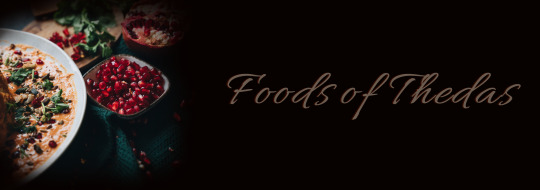
Updated: 2023/12
I originally posted this on my old blog. Since posting that, I've found other foods, drinks and ingredients. As of now this list is updated with everything found in media released as of Oct 2023.
Like the original, this is still a very long post that contains all canonical desserts, dishes, drinks, ingredients, and sauces. Unlike the original, I could not list canonically suggested food and ingredients, nor every codex, item, letter, ect in the sources. Because it was too long. I did add them to the individual post.
Like in the individual posts, the list has the country of origins next to each item and any relevant information. Such as ingredients, use, notes, or trivia. For the canonically suggested foods and drinks I list what their real world uses are for your reference as to what they might be used for in Thedas.
For Shorter Food Posts
Dishes, Sauces, and Sides
Drinks
Raw Ingredients
Prepared Ingredients
Canonically Possible Foods and Drinks
Disclaimer
Though real life plants may be listed here as edible it is for fictional use only. This is not intended to be used as a reference nor guide for what plants are edible or safe to eat. Please do not use it as such.
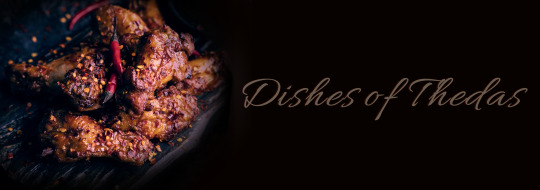
Dishes
Breads
Bark Bread
Biscuit
Whole Grain Biscuit - Commonly made in Chantry cloisters. A staple in their simple diets.
Black Bread
Braided Honey and Date Bread (Anderfels)
Brown Bread
Buns
Butter Puff - Bread made by folding butter into the dough allowing it to become puffy and softer than usual bread. (Orlais)
Crumpet
Dark Bread
Dried Bread
Flat Bread - A no-rise bread. Served with dip, brushed in oil, and/or as a side. (Nevarra)
Honey Loaf
Lichen Bread - Bread that is made using lichen. (Orzammar)
Black Lichen Bread
Peasant Bread - Comprised of wheat, grease, and salt in equal measure, made by Dalish and city elves in Orlais. They top it with butter, jam, and sometimes sugar. (Elves - Orlais)
Pumpkin bread - A favorite of Dorian Pavus (Tevinter)
Raider Queen’s Bread of Many Tongues - Created by the Raider Queen, this bread calls for flour, baking powder, salt, butter, brown sugar, molasses, eggs, bananas. The creator calls for Par Vollen bananas but another version of the recipe says Rivaini bananas are an acceptable replacement. (Rivain)
Rolls
Bread Roll
Sweet Rolls
Ryott Bread - Made of a protein rich grain called ryott. (Ferelden, Chasind)
Sweet Bread
Thin Bread - A thin bread used to make wraps in Seheron.
Whole Grain Bread - Another staple made in Chantry cloisters.
Wraps - Described as "soft" bread.
Appetizers, Starters, and Refreshments
Blood Orange Salad - a salad of bitter greens with blood orange slices served on top. (Nevarra)
Canapé - a type of hors d'œuvre.
Couscous Salad - A salad comprised of couscous with many varieties, one such variety includes red bell peppers and mint. (Rivain)
Crab Cakes - a classic dish in Kirkwall. (Kirkwall)
Dried Bread and Fruit
Eggs à la Val Foret - An egg dish served with a cream sauce. (Orlais)
Fluffy Mackerel Pudding - Celery, pepper, mackerel, diced onion, mustard, salt, Antivan pepper, ground mace, cardamom seed, eggs. Also known as Feast Day Fish (Ferelden)
Fried Crab Legs - A subsitute for the Orzammar dish of fried young giant spiders.
Fried young giant spiders - A common food in Orzammar, usually served with an alcohol-based sauce that varies with every establishment. (Orzammar)
Roasted Cave Beetles - Roasted whole and eaten out of the shell. (Orzammar)
Roasted Prawns - A substitute to cave beetles, said to have the same taste and texture.
Shredded Dried Meat and Cheese - A dish that is commonly used as a spread by the dwarves and used for lunches. (Orzammar)
Snails Dressed in Butter and Oil (Avvar)
Snails and Watercress Salad - A non-traditional dish inspired by Avvar cuisine featuring snails and watercress to appeal to lowlander pallets.
Stuffed Deep Mushrooms - A dish derived from various Orzammar deep mushroom delicacy. This Fereldan creation is stuffed with cheese and spinach. (Ferelden)
Rations, Tavern Fare, and Travel Food
Beer Nuts (Kirkwall)
Bread and Cheese
Chicken Wings - Sold in The Rusted Horn as ‘Wyvern Wings.’ (Ferelden)
Crow Feed (Antiva)
Dried Foods
Dried Fruit
Dried Meats
Fereldan Hearty Scones - a scone filled with bacon and cheese, careful, a mabari might snag it. (Ferelden)
Fish Pockets - A meal of fish, crisp vegetables, spices, and a soft wrap.(Seheron)
Fish Wrap - Fish wrapped in thin bread (Seheron)
Grey Warden Pastry Pockets - A hand pie filled with meat and other foods. Olesian Grey Wardens put their own twist using Olesian puff pastry.
The Hanged Man's Stew - The tavern’s featured dish, made with a different mystery meat every morning. (Kirkwall)
Jerky
Jerky Ball
Spiced Jerky
Meat Skewers - A portable snack. A known Orlesian version of this snack is primarily eaten by nobles while out on hunts and are not interested in the hunt, made of meat, cheese, and wine-soaked fruit.
Pickled Eggs - Eggs, sugar, salt, vinegar, and various spices and seasoning of the cooks preference. Favored in Ferelden and seen as a cure all. Served in nearly every Fereldan tavern. (Ferelden)
Pig Oat Mash - A constant dish on The Hanged Man menu, a popular hangover cure if washed down with brandy spiked cider. This warming porridge contains apples, dried salt pork or smoked bacon, dried rolled oats, berries, ale or water (Kirkwall)
Poison Stings - "Poison stings" is the colloquial name. Orange peels coated in chocolate, a crunchy yet chew texture that is both sweet and sour. A favored snack of Dorian Pavus when traveling from Tevinter to Ferelden. (Tevinter)
Provisions and Rations - Typically consist of dried meat, nuts, and a variety of other simple foodstuffs.
Dry Ration
Hardtack
Qunari Ration
Stuffed Vine Leaves - Common tavern food in Tevinter, stuffed with rice, herbs, and sometimes minced meat. Can be topped with lemon juice or tzatziki sauce.
Treviso Energy Balls - Made of peanut butter, oats, and dried fruit, it is a famine food invented during the occupation of Treviso in the Qunari Wars/The New Exalted Marches.
Unidentified Meat - Despite it's ominous name, it's simply chicken legs. Sometimes served with Nevarran flat bread. (Tevinter)
Dips, Glazes, Gravy, and Sauces
Apples Stewed in Brandy Sauce
Applesauce
Cherry Sauce
Cheese Sauce
Cream Sauce
Deep Mushroom Flavored Cream Sauce - Commonly served with seared nug. (Orzammar)
Dragon’s Blood Sauce (Nevarran)
Gravy
Honey-glaze - A sauce used to glaze various foods, particularly meats.
Hot Sauce
Llomerryn Red Sauce - A sauce that goes on almost everything, contains pulped tomatoes, onions, red pepper, brown sugar, apple cider vinegar, mustard powder, hot pepper powder, salt, cinnamon stick, allspice, cloves, fennel seeds, dill seeds, mustard seeds, black peppercorns, bay, garlic. (Rivain)
Mushrooms cooked in ale - One recommendation for this sauce is to be served over roasted nug.
Mushroom Sauce
Nesting Roast Gravy - Gravy made from the pan juices of a nesting roast. Meant to be served with the roast. (Orlais)
Plum Sauce
Red Wine Marinade
River-herring Gravy - a gravy as white as apple blossoms. (Orlais)
Special Sauce - A sauce infused with the essence of fifty-two herbs, prized for the ability to help with “inadequacy”. (Kirkwall)
Spider Leg Sauce - a variety of alcohol-based sauces unique to each Orzammar establishment, meant to be paired with fried young giant spider legs.
Tzatziki Sauce - Served with stuffed vine leaves. (Tevinter)
Wild Flower Glaze - A honeyed glaze made of wild flowers, it is recommended to use flowers plucked at dawn and the lowest blossoms. (Anderfels)
Yogurt Dip - Often served with flat bread (Nevarra)
Soups and Stews
Barley Soup
Blood Soup - Merrill is credited with the creation of this creamy beetroot soup, it is topped with roasted chickpeas. (Dalish)
Butter Soup - A simple, inexpensive, and easy soup. Made as midmorning meals or midday refresher for field workers. It is commonly fed to children and convalescents due to its nutritious nature. Ingredients include water, potatoes, cinnamon, star anise, clove, bay, peppercorns, salt, noodles, cream, butter (Orlais)
Cabbage Stew (Ferelden)
Deepstalker Stew - A stew of deepstalker is made when rations run low. (Legion of the Dead)
Denerim-rabbit Stew - Made with rat (City Elf)
Enchantment Soup - Made by Sandal, edibility unknown.
Fereldan Potato and Leek Soup
Fereldan Turnip and Barley Stew - White beans, oil, onion, carrots, celery, garlic, stock, turnips, turnip greens, sausage, barley, cumin, dried basil, oregano, salt, pepper, herbed wine vinegar
First Day Festival Stew (Orzammar)
Fish Chowder (Antiva)
Fish Stew
Lamb and Pea Stew - Alistair has his own version of this soup. (Ferelden)
Lentil Soup - A universal soup, with lentils being common in every Thedosian pantry.
Nettle Soup
Norbotten Fruit Stew - This dish is used to rehydrate dried fruits: dried apricots, pitted prunes, raisins, mixed dried fruits (cherries, apples, cranberries, etc), lemon or orange, cinnamon, cloves, water, sugar or honey, brandy. (Anderfels)
Pea Soup
Ram Stew (Ferelden)
Sweet and Sour Cabbage Soup (Ferelden)
Turnip Stew (Ferelden)
Turnip-Goat Stew (Ferelden)
Wild Rabbit Stew
Main Course
Alamarri Pickled Krone - Krone, Brine, (optional) pine pitch and druffalo dung.
Baked Fish - An Avvar cooking method where they wrap fish in pungent leaves and clay before cooking it in banked coals. (Avvar)
Baked Krone with Honey - The honey is typically used as a side sauce for dipping. (Fereldan)
Beans and Bread
Boiled Roots
Braised Nug with Elfroot (Dwarven)
Braised Ram with all the Trimmings (Ferelden)
Broiled Boar Head (Fereldan)
Cacio e pepe - A dish of three ingredients; spaghetti, pepper, and pecorino romano. (Antiva)
Dalish Deep Forest Comfort - String squashes, halla butter, garlic, mushrooms, elfroot or spinach, diced tomatoes or beetles, hot red pepper, rock salt, halla cheese or goat cheese, edible wildflowers (borage, chicory, etc), pine nuts. (Dalish, Southern Orlais)
First Day Chicken - a dish served during First Day in some parts of Orlais. (Orlais)
Fish in Salt Crust - Cooked much liked the baked fish, instead of using clay, the fish is covered in salt and wrapped in pungent leaves before being cooked in banked coals. (Avvar)
Fresh Oyster - Noted to go well with Llomerryn red sauce.
Fried Fish
Fried Mush (Orzammar)
Glazed Krone (Ferelden)
Gilded Swan with River-herring Gravy - An eastern spice, flour, gold leaf, river herring, swan, yolk. (Orlais)
Gnocchi (Antiva)
Goat Custard - A broiled goat head, not to be confused with the dessert. (Ferelden)
Grilled Poussin - Grilled chicken, typically a younger chicken. (Chasind)
Ham
Anderfels Smoked Ham - It tastes of despair
Avvar Ham
Ham Stuck with Cloves
The Jade Ham - Honeyed with wild flowers (especially those picked at dawn), masterfully seasoned, and spiral-cut. Not considered edible but better used as a weapon. (Anderfels)
Orlesian Ham
Smoked Ham
Herbed Chicken and Biscuits (Ferelden)
Jellied Meats
Jellied Pigs Feet - A delicacy in the Free Marches and originally a popular commoner food that has risen to the tables of nobility. Pigs feet and/or pork hocks, salt, onions, garlic, allspice, peppercorns, bay. (Free Marches)
Veal Galentine (Orlais)
Liver
Lutefisk
Nesting Roast - This dish is classically made with a quail stuffed in a pheasant stuffed in a swan. Served with gravy made from the pan juices. (Orlais)
Mad Burnard’s Gift of Flesh - A nesting roast unlike any other, involving a whole wyvern, stuffed with a whole gurn, stuffed with a horse, stuffed with a large halla (horns and all), stuffed with a swan, stuffed with a duck, stuffed with a quail, stuffed with a bunting that choked on a gold piece. (Orlais)
Nug Steak (Orzammar)
Nug-gets (Orzammar)
Nug-loaf (Orzammar)
Nug-Nug - A dish meant to resemble a nug peeking from its burrow; made of ground meat (beef preferred), parsley, egg, salt, crushed cumin or mustard seeds, black pepper, cooked rice, tomatoes, onions, chives (Orlais)
Paella - Made with rice, saffron, and a variety of seafood; such as shrimp, cuttlefish, and mussels. (Antiva)
Pancake - The breakfast food and savory dishes.
Crepes - A very thin pancake that can be filled with sweet or savory ingredients. (Orlais)
Hearth Cakes - Described as a common fare where they are baked on an iron griddle. They are made with halla butter (can be subbed for goat or cow butter), flour, hardwood ash (can be replaced with baking powder), cinnamon, ginger, nutmeg, sugar, mixed dried fruit (like cranberries, raisins, and currants), an egg, and milk. Described as baeing crispy and flaky on the outside, but remains moist on the inside. They are grilled on one side and then are flipped over, ensuring they are all crisp and bown. (Dalish)
Nug Pancakes - A savory pancake made with nug. A favorite among dwarven children. (Orzammar)
Porridge
Bland Porridge
Deer Porridge - A savory porridge served with deer.
Porridge with Raisins
Savory Porridge - Served with meat, vegatables, or spices.
Pudding - A sweet or savory, steamed dish that can be topped with gravy or chocolate.
Rack of Ribs (Ferelden)
Ram Chops (Ferelden)
Ram Cutlet (Ferelden)
Rice and Boiled Vegetables (Tevinter)
Roast
Gurgut Roast with Lowlander Spices and Mushroom Sauce (Avvar)
Roast Boar - One cooking method involves the boar being stuffed with apples (Ferelden and Orlais). Another has it served with a side of candied yams.
Roast Chicken
Roast Duck
Roast Hog
Roast Lamb
Roast Turkey - Common in the Free Marches, especially among Starkhaven nobility, as well as the Chasind.
Roast Wyvern - Common with the Avvar and Orlais.
Roasted Cave Beetle (Dwarven)
Roasted Giant Spider (Dwarven)
Roasted Nug (Orzammar)
Roasted Phoenix - One of the most infamous meals in Thedas, it is served with sweet red wine.
Roasted Rabbit
Roasted Venison with Wild Greens - The venison is seasoned with mint and pepper, served with wild greens and sweet pastries. Paired with wine to drink. (Ferelden)
Slow-roasted Nug-let (Orzammar)
Spit-roasted Deepstalker (Dwarven)
Spit-roasted Nug with Hot Sauce (Orzammar)
Sandwich
Ham Sandwich
Sausage - There are about twelve different kinds of sausage unnamed mentioned in Last Court.
Black Pudding - A type of blood sausage made from pork or beef blood, pork fat or beef sue, and a type of cereal. (Orlais)
Smoked Sausage
Spiced Sausage
Savory Pies
Dove Pie - A pie made with live doves, for the theater of the meal. (Orlais)
Nug Bacon and Egg Pie (Ferelden)
Pigeon Pie
Pork Pie
Starkhaven Fish and Egg Pie - Fish from the Minanter River (carp, trout, or others), wine, onion, carrot, thyme, bay, sea salt, dried currants, sliced almonds, boiled sliced eggs, butter, flour, fish broth, milk, salt, pepper, nutmeg, cream, fried whitebait or other small fish. (Starkhaven)
Turnip and Mutton Pie (Ferelden)
Unmentionable Pie - It is a meat pie that uses the typically undesirable parts of an animal. (Ferelden)
Venison Pasty - A hand pie filled with venison. In Serault, it is served with curls of goat cheese. (Orlais)
Seared Nug - Usually served with a deep mushroom cream sauce. (Orzammar)
Simmering Partridge - Cooked with sweet onions and pale beans (Orlais)
Smoked Meat
Smoked Boar
Smoked Fish
Smoked Rabbit
Smoked Venison
Spiced Nug
Stuffed Cabbage - A seasoned cabbage head stuffed with meat.
Venison with Apples Stewed in Brandy Sauce
Wandering Hills - A delicacy made from large creatures of the same name. (Anderfels)
Wyvern Steak
Sides
Antivan Olives - Soaked in vinegar and stuffed with capers.
Boiled Turnip (Ferelden)
Brandy Soaked Cherries (Orzammar)
Candied Yams
Croutons
Fried Potatoes - Recommended to be served with Llomerryn red sauce.
Hard-boiled Egg
Honey Carrots - Most common in Orlais where it is traditionally sweeter compared to other places due to the use of honey.
Jarred Olives (Tevinter)
Jellied Eels (Ferelden)
Mashed Turnip (Ferelden)
Peeled Grapes (Tevinter)
Picked Foods
Pickled Apples
The Pickled Apples of Arlathan - Apples said to be from the time of Arlathan. The taste is described to be one of fresh apples, with the same crispness.
Pickled Fish
Pickled Lamprey
Pickled Nug
Pickled Ox Tongue
Pickled Vegetables
Pickles
Roasted Chestnuts (Nevarra)
Roasted Figs (Rivain)
Roasted Potatoes - Recommended to be served with Llomerryn red sauce.
Roasted Turnip (Ferelden)
Sera’s Yummy Corn
Smoked Bacon
Steamed Beans
Steamed Turnips (Ferelden)
Stir-fried Turnips (Ferelden)
Toast
Toasted Bread - Used for dipping in stews.
Toasted Chickpeas - Used as a topping for soups and salads, sometimes as a replacement for croutons.
Wine Soaked Fruit
Baked Goods, Desserts, and Sweets
Bread Pudding - Made with stale bread, eggs, milk or cream, and other ingredients varied by if it is savory or sweet (Ferelden)
Cake
Cake with Apples
Cake with Nutmeg
Chocolate Cake
Cupcakes
Cherry Cupcakes - Historically a common method used to poison people, often served in the theater. (Tevinter)
The Exquisite Misery - A little cake topped with a dusting of anise, deep mushrooms, and gold dust. (Orlais)
Found Cake - A chocolate cream cake topped with white frosting and strawberries (Ferelden)
Hearth Cake - A pan-made cake; made of flour, hardwood ash or baking powder, halla butter, sugar, mixed dried fruit (currants, cranberries, etc), egg, milk. (Dalish)
Honey Cake (Orlais)
Lamprey Cake - contains no actual lampreys, it is modeled after the appearance of lamprey.
Lemon Cake
Petit Fours (Orlais)
Pound Cake
Round Cake - Often topped with poppyseed and honey. In Serault, they will sometimes have the antlers baked into the crust. (Orlais)
Sponge Cake (Orlais)
Sugar Cake - One version is made with strawberries and sugar-cream icing dressed on a pound cake. (Ferelden) Another version is made with a "humble cake" and is dressed with butter, sugar, and almonds. Both are seen as great gifts and good pick-me-ups after long days of traveling, and are often served by merchants.
Sugar-drizzled Lemon Cake - A type of lemon cake that was used in Antivan Crow history to assassinate templars.
Sugarcake - A dense cake usually topped with powdered sugar.
Sweet Cake
Wedding Cake
Candy
Black Licorice Candy - Can be salted. (Tevinter)
Bon-bons
Candied Almonds
Candied Fruit
Candy Apple (Ferelden)
Candied Dates (Tevinter)
Candy Cane
Carastian Candy - A candied chocolate. (Tevinter)
Peppermints
Spun Sugar (Ferelden)
Sweetmeat - A confectionery treat, sometimes candy coated fruit.
Toffee
Unnamed Candied Nuts with Spice - A candy that is sweet until swallowed, then they leave a spicy aftertaste. (Orlais)
Cobbler
Dalish Forest Fruit Cobbler
Strawberry and Rhubarb Cobbler (Ferelden)
Cookies
Biscuit - A hard, flat, and unleavened baked treat that can be sweet or savory.
Butter and Sugar Cookie - This cookie isn’t specified as it is only described by these ingredients.
Raisin Cookies
Shortbread
Tea Biscuits
Wafers
Custard
Goat Custard - Differing from the Fereldan savory counterpart. This custard is made throughout Thedas with goat milk and has numerous varieties. On pairs it with roast fig. A Rivain variation uses milk of the Ayesleigh gulabi goats specifically for its sweeter milk.
Donuts
Ice Cream
Orlesian Guimauves - Another name for marshmallows.
Pastries
Antivan Apple Grenade
Cinnamon Rolls - one of Varric's favorite pastries.
Croissant - Vivienne starts every morning with one. (Orlais)
Honey and Nut Pastry (Tevinter)
Macaroon
Marie du Lac Erre’s Sweet Ruin - One version of this pastry with a dramatic history, the recipe contains; butter, powdered sugar, chocolate, vanilla extract, flour, orange or mint extract, baking powder, and milk. (Orlais)
Tarts
Unnamed Blueberry Pastry - A light, sticky pastry with blueberries. (Possibly Nevarra)
Varric's Favorite Pastry - A pastry spread created by Devon, a Fereldan cook, after consulting with Varric Tethras on his favorite pastry.
Pie
Apple Pie
The Blessed Apple - A pie made by a small cloister of Chantry sisters tending to the orchard, they use the windfall apples and share the pies freely; as well as the apples. The ingredients are flour, salt, butter, water, apples (golden apples from Lady’s Orchard preferred but others are acceptable substitutions), brown sugar, salt, cinnamon, nutmeg, and cloves. (Orlesian)
Minced Pie - filled with finely chopped fruit and sweet things.
Pudding
Blancmange - A white pudding made of milk or heavy cream, its name is Orlesian for "white eating". Because of the mild, sweet taste it can have a variety of toppings such as toasted almonds, ribbons of fresh mangos, red grape compote, cherry saus, or Vivienne's preferred plating of white chocolate curls with whole jasmine flowers. (Orlais)
Caramel Pudding
Dessert Pudding
Rice Pudding
Scones
Sour Cherries in Cream (Orlais)
Sticky Figs Rolled in Nuts (Tevinter)
Sticky Jellies (Orlais)

Drinks
Absinthe
Absence - One of the bottles of Thedas you find in Inquisition.
Absinthe - also referred to la fée verte - “little green fairy”
Petite Absinthe - Made from a certain type of wormwood.
Ale, Beer, Drafts, Lagers, Malts, and Stouts
The Tapster’s Tavern in Orzammar serves 52 types of ale, some are listed.
Ale
Ander Stout - This stout is stored in oak casts. (Anderfels)
Barley Wine - Despite its name, this is an ale.
Beer
Brakien Brew (Orzammar)
Brown Ale
Coconut Draft (Orzammar)
Fereldan Beer
Fereldan Lager - A pale ale.
Lichen Ale (Orzammar)
Lichen-malt (Orzammar)
Oghren’s Homebrew - An amber coloured ale with a slightly sweet, nutty flavor and described to have a hint of toastiness, and is spiced with cloves. (Dwarven)
Qunari Ale
Ryott Ale (Ferelden)
Ryott Beer (Ferelden)
Valenta’s Red (Orzammar)
Watered Beer - While watered beer is served to reduce the price of beer and stretch it along, it is also served as a provision. In Serault, the peasantry drink watered beer to stave off the summer heat.
Watered-down Ale
Wildwine - An ale made from ryott. (Chasind)
Wilhelm’s Special Brew - This dark-colored ale gives off a thick, oaky smell. When swirled in its tankard, it takes on an unexpected glow. (Ferelden)
Brandy
Ammazzacaffe - A drink taken after coffee to dull the taste or effects. Though it can be a small glass of any liqueur, it is usually brandy. (Antiva)
Aged Antivan Brandy
Antivan Brandy
Antivan Plum Brandy
Apple Brandy (Orlais)
Orlesian Brandy
Plum Brandy
West Hill Brandy (Ferelden)
Cider
Brandy-spiked-cider
Cider
Serault Cider (Orlais)
Winter Cider (Wycome)
Cocktails
Benediction - Made of Prophet's Larel gin, served with a wedge of lime, and a thimble of Golden Scythe.
Elfroot mixed with Dandelion Wine - A restorative draft. (City Elves of Orlais)
The Emerald Valley - A spirit distilled of over seventy different herbs and flowers by the Chantry sister in Lydes, it is topped with egg-white foam and dusted with nutmeg. Described as having a varied and complex flavour, fresh like a lush green valley. (Orlais)
Dragon’s Piss - The name is probably figurative, but no one knows for sure. BioWare gives the “recipe” for Dragon Piss as “1 oz light rum, 1 oz dark rum, filled with iced tea”. "Dragon's Breath" is offered as an alternative name for this drink as it is served while lit on fire in the glass and burns on the way down.
The Golden Nug - Made with a base of effervescent white Seleney wine, sweetened with a dash of West Hill brandy and a splash of pomegranate juice. Muddled with raspberries and garnished with a sprig of Royal Elfroot. The goal is to imitate the soft pink colour of a nug.
The Heart of Spring - A “restorative” drink from Verchiel made with violets. (Orlais)
The Hissing Drake - Mix of cinnamon-infused whiskey, darl Llomerryn rum, and Hirol's Lava Burst.
Ice Cream and Beer
A Night of Shame - Antivan port with a dash of chocolate bitters and a twist of orange, served in a flute of chilled Serault glass. (Orlais)
Orichalcum mixed with wine - Considered to have aphrodisiac properties.
Posset - A drink made of hot milk curdled with ale, wine, or other liquor and typically flavored with spices. Can be drunk as a delicacy or as a cold remedy.
The Randy Dowager - Rumored to be created by the editor of the periodical, it is a tall glass of Abyssal Peach liquor and fresh cream, garnished with sugared rose petals and served on a silk handkerchief with a scandalous rhyming couplet inked by the bartender. (Orlais)
To Cure a Cold - a folk remedy that requires boiling whiskey and adding lemon juice and crushed garlic.
Gin
Gin
Prophet’s Laurel Gin (Orlais)
Grey Warden Liquor
These are bottles unique to members of the order, as each warden will combine half-full bottles in order to save space. No bottle is ever fully emptied or cleaned. In order to preserve the base flavor. They are called Grey Whiskey, Ritewine, or Conscription Ale, each vintage is named after a warden with a small note.
Vintage: Warden Anras - Bottled whimsy.
Vintage: Warden Bethany Hawke - Princess piss.
Vintage: Warden Carver Hawke - Toast them all.
Vintage: Warden Daedalam - Extra red.
Vintage: Warden Eval’lal - Griffon Wing Ale
Vintage: Warden Gibbins - Don’t frigging touch! I spit in this! I mean it!
Vintage: Warden Jairn - Smash when dead.
Vintage: Warden Korenic - Notes of fruit and anger.
Vintage: Warden Riordan - Serve yourself.
Vintage: Warden Steed - Joining juice.
Vintage: Warden Tontiv - Home.
Mead
The Tapster’s Tavern in Orzammar serves 17 types of mead, some are listed. Honeywine is another name for mead.
Avvar Mead
Chasind Sack Mead
Lady Odette Guillory’s Family Honey Wine (Orlais)
Mead
Orlesian Honeywine
Port A sweet, fortified red wine, typically served with dessert.
Antivan Port
Tevinter Port
Rum Boot Screech is another name for rum.
Alvarado’s Bathtub Boot Screech
Blackwater Rum (Wycome)
Dark Llomerryn Rum
Tea and Other Drinks
Coffee (Antiva)
Cocoa/Hot Chocolate
Juice
Fermented Fruit Juice
Pickle Juice
Pomegranate Juice
Prune Juice
Punch
Spicy Punch
Tea
Almond Tea (Orlais)
Bitter Tea - An unspecified tea so bitter it is astringent. Served during the Fourth Blight.
Black Tea
Black Tea with Juniper
Fires of Change Tea (Orlais)
Herbal Tea
Iced Tea
Lattenfluss Tea (Anderfels)
Mint Tea
Anderfels Mint Tea
Nameless Tevinter Tea
Rivaini Spice Tea Blend - Blend of cinnamon, ginger, and cloves. One of the teas from Rivain known for its healing properties. Empress Celene commonly uses this tea to stave off headaches.
Rivaini Tea
Rivaini Tea Blend - A blend of licorice root, oregano, lemon verbena, and peppermint. One of the teas from Rivain known for its healing properties. Rumored to be favored by Empress Celene to stave off headaches.
Rosehips Tea (Orlais)
Spiced Tea (Nevarra)
Stripweed Tea (Tevinter)
Unsweetened Tea
Verimensis Tea (Tevinter)
Whiskey
Cinnamon-infused Whiskey
Ferelden Whisky
Legacy White Shear
Mackay’s Epic Single Malt
Wine
The Tapster’s Tavern in Orzammar serves 12 types of imported wines, some are listed.
Agreggio Pavali (Tevinter)
Alyons Black (Orlais)
Amaranthine Red (Ferelden)
Anderfels Red
Antivan Red
Bitter Black Wine (Orlais)
Bottled Scar 5:34 Exalted - A rare collaboration between human and elf vintners.
Celestine Black Wine (Orlais)
Dalish Wine
Dandelion Wine (City Elves of Orlais)
Elderberry Wine (Ferelden)
Finale by Massaad (Orlais)
Flames of Our Lady (Orlais)
Flat Wine
Ghislain Red (Orlais)
Iced Wine - Mentioned in both Tevinter and Orlais.
Montsimmard White (Orlais)
Mosswine (Orzammar)
Mulsum (Tevinter)
Orlesian Red
Plum Wine
Red Wine
Serault Yellow Wine (Orlais)
Serault White (Orlais)
Silent Plains Piquette (Tevinter)
Southern Black Wine
Spiced Wine
Sweetened and Spiced Yellow Wine
Val Chevin Red Wine (Orlais)
Vint-9 Rowan’s Rose (Tevinter)
Watered Wine
White Seleny Wine (Antiva)
White Wine
Yellow Wine
Additional Spirits
Abyssal Peach
Antivan Sip-Sip
Aqua Magus
Aquae Lucidius - A potent liquor made of wyvern venom; a rare drink known for its hallucinogenic properties.
Bottle of Rotgut - Rotgut is slang for cheap whiskey.
Butterbile :84
Carnal 8:69 Blessed (Orlais)
Dwarven Ale - Not actually an ale, but a black liquid reputedly made from fungus with a reputation as being almost undrinkable for anyone not a dwarf.
Garblog’s Backcountry Reserve
Golden Scythe 9:40 Black
Hirol’s Lava Burst (Kal'Hirol)
Maraas-Lok (Qunari)
Moonshine
Potent Moonshine
Sun Blonde Vint-1 (Tevinter)
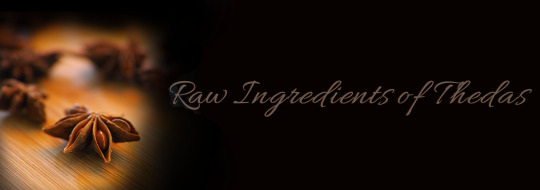
Raw Ingredients of Thedas
Fruits, Mushrooms, Nuts, and Vegetables
Edible Plants
Bark
Fern Fiddlehead (Avvar)
Hops
Lichen (Dwarves)
Black Lichen - Toxic unless properly cooked.
Moss (Dwarves)
Nettle
Pungent Leaves - Unspecified leaves. (Avvar)
Rose (Orlais)
Rose Petals
Rosehips
Stripweed (Tevinter)
Sugar Cane (Orlais, Tevinter, Rivain)
Vine Leaves (Tevinter)
Watercress (Avvar)
Wildflowers
Borage
Chicory
Dandelion
Honeysuckle
Jasmine
Violet
Fruits and Nuts
Apple
Applewood Apples (Orlais)
Golden Apples (Orlais)
Green Apples
Le Pomme Vie et Morte - Apples that grow by the gallows in Val Royeaux. (Orlais)
Red Apples
Windfall Apples
Apricot
Banana
Par Vollen Banana
Rivain Banana
Berry
Blackberry (Ferelden)
Blueberry
Cranberry
Currant
Black Currant
Elderberry (Ferelden)
Raspberry
Strawberry (Ferelden)
Caper (Antiva)
Cherry
Black Cherry
Sour Cherry - unspecified variety(ies)
Sweet Cherry - unspecified variety(ies)
Cocoa/Chocolate (Donarks)
Coconut
Coffee (Antiva)
Date - A purple and red fruit with a pit, it has a sweetness and tangy taste. (Tevinter)
Fig (Tevinter)
Grape
Red Grape (Orlais)
Lemon
Lime
Mango
Nuts
Almond
Chestnut
Pine Nut
Olive
Antivan Olive
Orange (Antiva, Orlais, Tevinter)
Blood Orange (Nevarra)
Passion Fruit (Antiva)
Peach
Pear
Plum
Pomegranate (Tevinter)
Pomegranate Seeds
Grain
Barley
Fereldan Barley
Pot Barley
Oats
Rolled Oats
Rice (Antiva, Rivain)
Ryott (Ferelden)
Wheat
Durum Wheat (Rivain)
Whole Grains
Mushrooms
Deep Mushroom
Field Mushroom
Unspecified Fungus - Used to brew Dwarven ale.
Truffle
Unnamed Glowing Fungus
Wild Mushroom
Vegetables and Legumes
Beans
Bush Beans (Free Marches)
Green Beans (Orlais)
Pale Beans (Orlais)
White Beans (Orlais)
Beet
Cabbage
Carrot
Purple Carrot (Orlais)
White Carrot (Orlais)
Celery
Chickpea (Rivain)
Chive
Corn
Checkered Corn
Golden Corn (Orlais)
Yellow Corn
Cucumber
Eggplant (Antiva, Ferelden)
Fennel (Orlais)
Leek
Lentils
Lettuce
Mustard
Onion
Red Onion (Orlais)
Sweet Onion (Orlais)
White Onion
Pea
Peanut (Antiva, Seheron)
Pepper
Antivan Pepper
Green Pepper
Hot Pepper
Hot Red Pepper
Red Bell Pepper (Rivain)
Sweet Pepper (Orlais)
Potato
Radish
Daikon Radish (Ferelden)
Rhubarb (Ferelden)
Spinach
Squash
Marrow Squash
Pumpkin
String Squash
Tomato
Turnip - aka navet
Turnip Greens
Wild Greens
Yams (Ferelden)
Animal Products
Dairy
Cream
Heavy Cream
Milk
Cow Milk
Goat Milk
Halla Milk
Ram Milk
Soured Milk
Eggs
Caviar
Chicken Egg
Fish and Seafood
Carp
Cod
Crab
Cuttlefish
Eel
Krone
Lamprey
Mackerel
Mussel
Oyster
Prawn
River Herring
Shrimp
Sunfish
Trout
Whitebait
Insects
Cave Beetle (Dwarven)
Giant Spider (Dwarven)
Scorpion
Snail (Avvar)
Wood-burrowing beetle larvae (Dalish)
Meats
Beef
Ox
Ox-tongue
Veal
Boar
Bronto (Orzammar)
Cat - mentioned to be eaten in Orlesian alienages by those most desperate (City Elves of Orlais).
Dog - mentioned to be eaten in Orlesian alienages by those most desperate (City Elves of Orlais).
Druffalo
Giant (Tevinter)
Goat
Gurn
Halla
Hare
Hart
Horse
Liver - General name given, animal isn’t specified.
Nug
Pork
Pig’s Feet
Pork Hocks
Pork Saddle
Rabbit
Ram
Rat - mentioned to be eaten in alienages by those most desperate (City Elves of Anderfels, Ferelden)
Sheep
Lamb
Mutton
Venison
Wandering Hills (Anderfels)
Poultry and Reptiles
Bunting
Chicken
Poussin (Chasind)
Deepstalker (Dwarven)
Dove
Dracolisk (Tevinter)
Dragon (Nevarra, Orlais)
Duck
Gurgut (Avvar)
Lurker (Avvar)
Partridge
Pheasant
Phoenix
Pigeon
Quail
Quillback
Swan
Turkey
Varghest
Wyvern (Avvar and Orlais)
Misc.
Dragon Blood (Nevarra)
Druffalo Dung
Honey
Honeycomb
Miscellaneous Ingredients
Baking Ingredients
Ash
Elfroot Ash
Hardwood Ash (Dalish)
Baking Powder
Yeast Cake
Salts
Fine-ground Salt
Rock Salt
Salt
Sea Salt
Others
Brine
Clay (Avvar)
Pine Pitch (Alamarri)
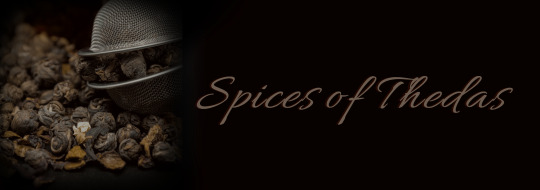
Herbs and Spices
Herbs
Basil - Mentioned to be grown in Serault, Orlais.
Dried Basil
Bay Leaf
Catsbane
Elfroot
Elfroot Leaves
Royal Elfroot
Lavender (Orlais)
Mint
Anderfels’s Mint
Foxmint
Peppermint
Oregano
Dried Oregano
Parsley
Prophet’s Laurel
Rosemary
Spindleweed
Verdant Spindleweed
Thyme
Spices
Allspice
Anise
Antivan Cord-seed
Cardamom
Cinnamon (Rivain, Seheron)
Clove
Cumin
Cumin Seed
Deep Mushroom Powder (Orlais and Orzammar)
Dill
Dill Seeds
Eastern Spice - Unnamed
Fennel
Fennel Seeds
Garlic
Ginger
Dried Ginger
Hot Pepper Powder
Hot Red Pepper, Crushed
Juniper
Licorice
Mace
Mustard
Mustard Powder
Mustard Seeds
Nutmeg (Seheron)
Grated Nutmeg
Ground Nutmeg
Pepper
Black Pepper
Peppercorn
Black Peppercorn
Poppyseed
Saffron
Spice Ball - A variety of mixed spices wrapped in a cheesecloth
Star Anise
Vanilla (Rivain)
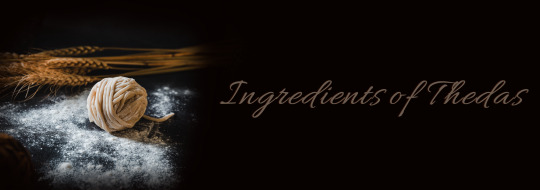
Prepared Ingredients
Basic Ingredients
Alcohol
Brandy
Cinnamon-infused whiskey
Dark Llomerryn Rum
Hirol’s Lava Burst
Prophet’s Laurel Gin
Red Wine
Watered Down Ale
Whiskey
White Seleney Wine
Broth
Deepstalker Broth
Fish Broth
Butters - Non-dairy butters
Peanut Butter
Caramel
Cocoa Products
Chocolate (Orlais, Tevint)
Chocolate Bitters
Cocoa Butter - used to make white chocolate (Orlais)
Cocoa Powder - difficult to procure
White Chocolate (Orlais)
Compote - Fresh or dried fruit that is cut into chunks and stewed in a syrup of sugar and other flavours.
Red Grape Compote (Orlais)
Croutons
Custard
Dough
Pie Dough
Puff Pastry Dough (Orlais)
Extract
Mint Extract
Orange Extract
Vanilla Extract
Flour
Ryott Flour (Chasind, Ferelden)
Semolina Flour (Rivain)
Wheat Flour
Whole Grain Flour
Frosting
Buttercream
Chocolate Cream
White Frosting
Gold
Edible Gold Leaf
Gold Dust
Jam
Plum Jam
Raspberry Jam
Mulled Fruit
Mulled Raspberry
Oil
Cod Liver Oil
Orange Essence
Pasta
Antivan Pasta
Couscous (Rivain)
Gnocchi (Antiva)
Grain-based Noodle
Noodle
Pound Cake
Stock
Brown Stock
Sugar
Brown Sugar
Molasses
Powdered Sugar
Sugar-cream Icing
Sugar Flowers
Sugared Rose Petals
Syrup
Sugar Syrup
Tea Biscuit
Toffee
Wafer
Vinegar
Apple Cider Vinegar
Herbed Wine Vinegar
Dairy and Eggs
Butter
Cow Butter
Goat Butter
Halla Butter
Herbed Butter
Nug Butter
Cheese
Antivan Smoked Cheese
Blue-veined Cheese (Orlais)
Brie Cheese
Brined Goat Cheese
“Dalish” Cheese - An ill described item as it is unclear if it is actually cheese. One thing is for sure it isn’t Dalish.
Dry Cheese - Unspecified cheese used in cacio e pepe(Antiva)
Feisty Cheese (Orlais)
Goat Cheese
Halla Cheese (Dalish)
Ram Cheese (Ferelden)
Cream
Spiced Cream
Thickened Cream
Whipped Cream
Egg
Hard Boiled Egg
Yogurt
Dried and Cured Foods
Dried Fruits, Vegetables, and Fungi
Dried Apple
Dried Apricot
Dried Beans
Dried Cherry
Dried Cranberry
Dried Currant
Dried Mushroom
Dried Peas
Prunes
Pitted Prunes
Raisin
Cured Meats
Bacon
Nug Bacon
Smoked Bacon
Cold Cuts
Dried Meats
Dried Mackerel
Lutefisk
Jerky
Spiced jerky
Salted Meat
Dried Salt Pork
Salt Pork
Salted Beef
Salted Dragon Meat
Salted Fish
Salted Goat Meat
Sausage
Blood Sausage
Smoked Sausage
Spiced and Salted Sausage
Smoked
Smoked Beef
Smoked Fish
Smoked Goat Meat
Pickled Foods
Pickled Apples
The Pickled Apples of Arlathan - Apples said to be from the time of Arlathan. The taste is described to be one of fresh apples, with the same crispness.
Pickled Fish
Pickled Lamprey
Pickled Nug
Pickled Ox Tongue
Pickled Vegetables
Pickles
Prepared Animal Products
Gelatine
Grease
Ground Meat
Ground Beef
Ground Nug
Lard
Spiced Meat
Miscellaneous
Lyrium
Soup Bone
Wyvern Venom - There are 47 ways to distill wyvern venom to be safe for consumption.
Sources:
(If you want to find the direct links or page numbers, check out the Wiki's Food and Ingredients page.)
Primary Sources: Dragon Age: Origins (Base and DLCs) Dragon Age: Awakening Dragon Age 2 (Base and DLCs) Dragon Age: The Last Court Dragon Age: Inquisition (DLCs + Multiplayer)
Books: Dragon Age Tabletop RPG Core Rulebook Dragon Age Tabletop RPG: Blood in Ferelden Dragon Age Tabletop RPG: Game Master’s Kit: Buried Past World of Thedas Vol. 1 World of Thedas Vol. 2 Dragon Age Official Cookbook: Tastes of Thedas Dragon Age: The Stolen Throne Dragon Age: The Calling Dragon Age: The Masked Empire Dragon Age: Asunder Dragon Age: Last Flight Dragon Age: Tevinter Nights Short Story: Paper and Steel Short Story: Paying the Ferryman Short Story: Riddle in Truth Short Story: As We Fly
Comics: Silent Grove Mage Killer Knight Errant Deception
Wanna support this blog? Check out my ko-fi.
#dragon age#food lore#foods of thedas master post#alcohol cw#food cw#drinks of thedas#foods of thedas#ingredients of thedas#thedosian foods#thedosian fauna#thedosian flora#anderfels#antiva#avvar#chasind#dalish#ferelden#free marches#nevarra#orlais#orzammar#rivain#seheron#tevinter#city elf#qunari#long post#archi is archiving#this post is so long I kid you not when da4 comes out I will likely have to make a whole separate post
50 notes
·
View notes
Note
Hi Ramona! Long time listener, first time caller lol. I’ve been a big fan of CoE since you started it. Love the story and the setting. Also really like the intrigue of the most recent updated demo. Also wanted to say my go-to romance is usually Irus but I decided to switch it up and romanced Oren this last play though. I’m a changed woman, Ramona!! 🙌Oren’s route is so sweet and romantic and soft and thank god he’s got his head on straight because my MC does not with her no lmao. I also had some questions about CoE.
1. What will Dena be like as a RO? Any hints?
2. What are the basic food staples/diets of each country? We have seen foods from Vinia and I’m hungry every time I read them, but what about others?
Thank you so much for your support and I'm really pleased that Oren could win you over with his soft and gentle love 😊
I can't tell you for certain what Dena will be like since I normally just write as I go. Dena genuinely cares about the MC so they will be somewhat protective of the MC. As for the rest, you'll find out when I find out which is when I write their romance route 😅
That is a very good question! I answered a long way back so this might differ from then. Vinia: A mix of Ishari cuisine, seafood and lots of vegetables and red meat - out of all the regions, Vinia has the most diverse diets and food staples. There's a range of salts, spices and herbs that are used to season different dishes to give it a unique 'Vinia flavour'. Ishari: A lot of flatbreads, rice, spices and curries. Most of the meals made are cooked with what's available so meat and vegetable versions of the same dish are common. The food tends to be spiced and fragrant. Cyre: Cyre's cuisine is mostly seafood near the coast, but more inland, there's more meat (not seafood) available so the dishes will vary depending on the area. In places like Salt Bay, fish stews, grilled seafood and broths were the norm but in places more inland (and closer to the palace), you'll find lamb, vegetables and different types of cheese and breads available. Look hard enough and you'll also find variations of Ishari cuisine scattered about. Southern Islands: The Southern Islands are a lot like Vinia in that the cuisine is influenced by the different regions and traders that visit the islands. You'll find food from Cyre, Vinia and Ishari in the Southern Islands along with foods from elsewhere like the Nomad Tribes.
I didn't think anyone would really care about the different foods mentioned in the game, so I hope this answers your question! 😊
40 notes
·
View notes
Text
Crop Fields - Download
Round 8 - Rye
Rye became a staple in Europe during the Middle Ages, where it was cultivated and used to produce both bread and alcohol. Rye is hardy enough to grow in poor soils and cold temperatures, surviving in snow cover that would otherwise kill wheat. Known as the starvation grain, it kept countries alive when other resources failed, and became wildly popular in brewing alcohol due to it's spicy countenance. Bread making using this particular grain became popular as well, and can now be recognized as pumpernickle.
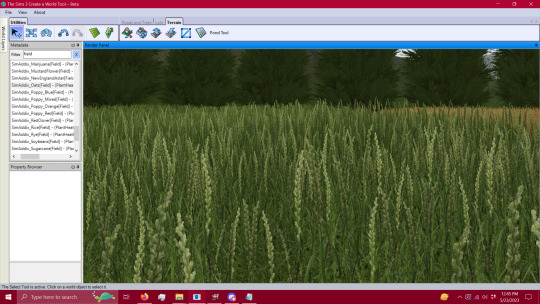



[Notes will be copied to further posts, considering they're all the same facts]
Notes:
These are UPDATED versions of my previous crop fields - If you have the old fields in your game, they will still work as they are separate plants, but please consider that the new fields are much lower in poly (game weight/size) than the old fields, and reworked to look better over large areas as they are fuller and circular in shape rather than an odd triangle. Please consider replacing them in your games.
These are giant fields. They are meant to fill empty space in CAW/Edit town - you can use them on lots, but as stated they are quite large so if you decide to use them as lot decoration hold onto your hat because they're gonna take up a chunk of ground.
I will be making smaller/single plants to match the fields, but it takes time so please be patient.
These are speedtree plants, so they'll "follow you" when you move around. However consider that any recolors of these plants will become a default replacement unless you make the package unique. So if you would like to recolor them to suit your current world, feel free to, but please make it it's own package so they don't override the original.
These are fairly large but have low polycount - coming in at 330 polys each. That means you can have several of these in one area without weighing down your game too much. That's a win for everyone.
Please feel free to tag me if you use them in your world, I love to see them in your games! <3
116 notes
·
View notes
Text
Mushrooms On Toast 2023
Breakfast and Brunch, Family Recipe, Mains, Simple Meals, Vegetarian
Difficulty: Easy | Servings: 1
Description:
My ever-so-slightly fancier take on a classic dish. (Only slightly—if you’re looking for a crab meat and bearnaise sauce-fancy version go find Marco Pierre White.) Suitable for brunch, lunch, or dinner. Serve with a simple salad.
Mushrooms on toast was always something I considered an easy dinner. It seemed like more of a legitmeal™️ than just making instant ramen or throwing something in the microwave, but not so complicated that I couldn’t manage it on my low energy/high pain days. As a bonus, most of the ingredients are staples in my kitchen.
I started with a fairly basic plan: “sauté sliced white mushrooms in butter with jarred minced garlic and worchestershire sauce. Serve on buttered toast. Top with poached or over-medium egg.” Over time, it evolved to sautéing a mushroom/green onion combo in butter with minced fresh garlic and thyme, then adding whole grain mustard and a bit of milk to make more of a sauce. Finally, one night I didn’t feel up to cooking eggs (because accidentally broken yolks are a freaking tragedy) so I decided to break the damned yolk on purpose and use the egg to make French toast as the base. ✨REVELATION.✨
My step-grandfather, Frank Otis (1932-1998), had worked as a country club chef for years and taught me to make French toast when I was maybe in junior high school. His version involved slices of a dense loaf topped with sesame seeds, dipped in a mix of one egg and just a splash of milk per slice, and shallow fried in a measurable depth of oil. Though I can’t quite remember the variety of bread he favored (maybe it was sold in a pre-sliced loaf as Texas toast?), I still rely on his egg+milk proportions.
Ingredients:
*All measurements given are approximations. Unlike baking, cooking isn’t always science. Some quantities, like garlic, you can only truly measure with your heart.
THE TOAST:
1 thick slice good quality bread (brioche if you can get it)
1 egg
1 tablespoon milk
Butter or oil for frying
THE MUSHROOMS:
2 large handfuls white mushrooms, cleaned and sliced
3 green onions, chopped and separated white/green (reserve some of the prettier green parts for a garnish)
2 cloves OR 1 tablespoon* minced garlic (fresh is great, but jarred is just fine. Conserve your energy as needed).
1 tablespoon dried thyme, crushed
Butter (or butter + olive oil) sufficient for sautéing
1 heaping tablespoon whole grain mustard (my favorite is Maille Old Style)
2 tablespoons whole milk or cream (adjust as desired)
Salt
Pepper
Finishing salt (like that jar of über-fancy fleur de sel your sister gave you a few years ago)
Directions:
For the toast:
Beat egg and milk in container large enough to fit the bread slice. Briefly soak bread in egg mixture. Cook in a sauté pan over medium heat, turning once, until golden brown on both sides. Pour any additional egg mixture in the pan and cook it, too. (Let it cool then give it to the cats—no sense wasting it!) Remove from heat; cover and keep warm in a wide, shallow bowl.
For the mushroom topping:
In the pan you cooked the toast in, add more butter. Add the garlic and thyme, then after that’s heated through and fragrant add the whites of the green onions. Cook for a few minutes. Add sliced mushrooms, salt**, pepper, and the remainder of the green onions (except the garnish bits), adding additional butter or oil if needed.
**Add a bit less salt than you think you need because you’re going to add the finishing salt later.
When the mushrooms are almost done cooking, add the mustard and milk and stir to incorporate.
Remove bread from the microwave (or wherever you’re keeping it warm). Spoon/pour mushroom mixture over the French toast. Add reserved green onions and finishing salt. Take a photo for Instagram as proof you cooked.
14 notes
·
View notes
Text
In honor of Starbucks declaring bankruptcy in Brazil, the country that drinks more coffee than the rest of the world, here is my ranking of Brazilian coffee options:
cafézinho: 10/10
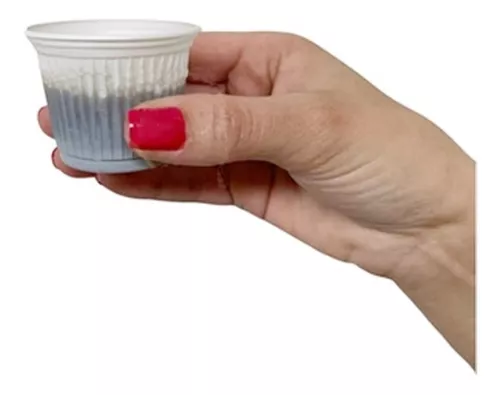
Our blessed little coffee or the small break coffee. Usually served as a courtesy after lunch in any restaurant. You can find this one literally anywhere in Brazil. Your office’s breakroom. Hospitals’ hallways. Literally any business that has a waiting room. The only place you won’t find it is in a dentist’s office for a matter of principle, I suppose.
Café da cantina da escola: 10/10

The coffee you find in school/colleges' cafeterias. Usually has more sugar than advised to serve to teenagers but that’s the point. Only costs R$ 1,00 to R$ 2,00 reais. Served in plastic cups so you can carry it around with you and hug it against your chest if you live in one of the four states that has a winter season. Kept me awake during many many boring classes.
Café no copo americano: 11/10
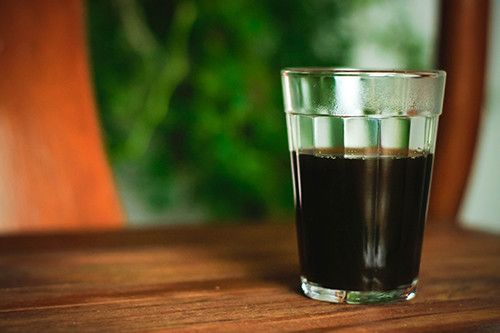
The one from the bakery/bar closest to your home/school/job. This cup, called ‘american’ for industry history reasons, is a staple of Brazilian culture. Does it taste good? Honestly I don’t know but habit is a powerful thing. You’re gonna drink this coffee until the day you die and think it is the best thing ever. Bonus points if comes with a pão na chapa.
Café do metrô de São Paulo: 10000/10
Literally any coffee served in the metro stations in São Paulo. This coffee keeps Paulistas - and consequently, the whole country - one step further from total collapse.
Café com requeijão: 10/10
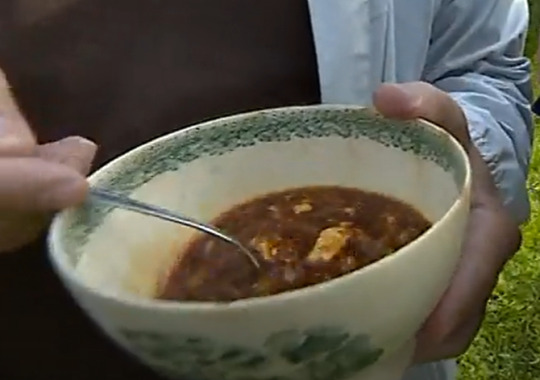
(sorry that's the best image I could find but it's really good I promise)
It’s coffee. And then you cut small pieces of a special type of Brazilian cheese and add to it for a burst of flavor. Makes your intestines work like crazy. Popular in the northeast region of Brazil. Not for everyone.
Café da casa da vó: 100/10

Your grandma’s coffee. She thinks you’re too thin. You’re not escaping her home anytime soon. The coffee is only an excuse for her to feed you. Must be served in the classic brown cup.
Café com leite: 10/10
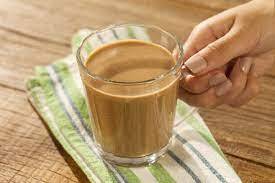
Half and half. Popular with kids. What do you mean kids aren’t supposed to drink coffee?
Café mineiro com pão de queijo: 1000000000+/10
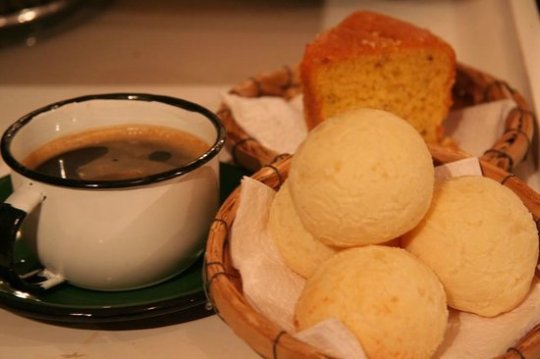
Minas Gerais’ coffee served with cheese bread. If you come to Brazil and don’t experience this combo, what are you even doing with your life? What’s the purpose of your existence? You’re gonna think about this flavor until the day you die.
#congratulations to starbucks for declaring bankruptcy in the country that drinks six times more coffee than the rest of the world#maybe we don't like overpriced things#who knows#coffee#café#brazilian stuff#brazilian coffee
45 notes
·
View notes
Note
"And those cowardly celebrities who leave usually come back with their tails between their legs, having seen that nobody missed them. We have our daily bread to earn, and it won't be Richard Gere or Rosie who will help us."
And they expect an audience or loyal fans when they return, right? I say "nay". Run away and stay away. Cancel yourself with your actions. Anon is right in that we "we have our daily bread to earn" and are forced to stay here, work hard, and overcome this economy because we are not entitled and over-privileged actors/celebrities with disposable income who can fly off to another land. We are the people of this society who keep it going, so my money does not go to the hypocrisy of these celebrity to THINK they have some influence. Overcoming tough times is hard, but we (the everyday person) will have to suffer, toughen up, and come out of this stronger and more enlightened when we see these jerks flaunted their privilege. While we budget for the overpriced eggs, milk, and basic staples, they get to poo poo from their cliff side homes and well stocked bank accounts. This is why accountability for their actions, words, hypocrisy, and tantrums is necessary. Don't fart in my face and try to call it a new cologne.
Celebrities and rich people live in their own world and they only pretend to understand how ordinary people live.
It's easy to give up everything and leave, selling real estate for tens of millions of dollars. There are many countries in the world that will gladly accept the rich, and then they will return to their native country when everything is fine there.
And make no mistake, there will be millions of fans who will welcome them.
2 notes
·
View notes
Note
Hi,
I know that you don't really focus on food or anything, but I was curious if you had any recipes for stuff you really enjoy that are typical to your country/home?
I've been browsing some wikipedia pages on pastries and dishes lately and I wanted to try making something, but I couldn't find it in me to choose from the almost infinite selection of things, so I thought asking my mutual from another part of the world may be a good idea :)
You can just give a name of something you feel is worth trying if you don't know/don't have the time/don't want to share a recipe, but I'd love to get a recommendation or two!
Hi! Yes, of course I'll tell you some of my fave dishes that I think are fairly easy to make (I mean, not that I cook, my specialty is putting frozen stuff in the oven or boiling something so yeah lmao). I'll drop some recipes I found in English for you, cannot vouch for them personally (again, since I can practically burn water), but maybe they're a useful jumping off point for you!
Chocotorta: This is the best cake/dessert in the world and it really is the stupidest thing to make. You need to get your hands on some dulce de leche, which I don't know how difficult that can be, but you get that, you get some cream cheese (that recipe says soft cheese? pretty sure that's not the same, get cream cheese, lmao), and you get whatever cookie can replace our chocolinas (basically any squareish, flat chocolate cookie).Then you mix the dulce de leche with the cream cheese until you get a light brownish mixture. You're gonna lightly soak the cookies in some milk or coffee (lightly, so they don't break), then you're gonna make a bed of them on a baking tray. Put a layer of the mixture on top of that, then another layer of cookies, then more mixture, etc etc. Then you chill, and ta-dah! You can leave it like that, fancy it up a bit, but that's the important part.
Pastel de papa (potato and ground beef pie): A really delicious dish, basically a pie or casserole made with mashed potatoes and ground beef all seasoned and with extra ingredients to make it really yummy. I leave you a recipe in english and one in spanish.
Empanadas: I mean, that's the classic! Basically our version of the 'food-encased-in-dough' staple across the globe. The traditional version is, again, with ground beef, but you can really put anything in there (other typical variants include ham and cheese, onion and cheese, corn paste, etc). IMPORTANT: If the recipe says use raisins for the filling, IGNORE IT, trust me, every good argentine will thank you (Personally I'd take out the olives too, but if you're my grandma I NEVER SAID THAT I LOVE RAISINS AND OLIVES NANA).
Milanesa napolitana: Another big fave, this is our breaded steak (usually fried, but it can go in the oven, it just takes longer), with added tomato sauce and cheese on top and it's delicious. Serve with fries or mashed potatoes for the perfect combo.
I hope that helps, let me know if you ever make some of these! Bone app the teeth! (and everyone else, feel free to drop some good argentinian recipes!)
#you really DID ask the worst person possible djfhdfkj i wish i could have pointed you in the direction of trusted recipes#but yeah i dont cook lmao. but loking over the ingredients they don't look bad so they should work!#(plus lets be honest theyre not complicated recipes so you should be fine!)#hopefully youre not vegan cause this is very much a meat-based recipe country lmao#argentina#juli answers#sorry if i rambled but whats a recipe post without some inane tangent lmao
9 notes
·
View notes
Text
Point of view on: Brazil x US
As an international student from Brazil studying in the USA, one of the biggest cultural shifts I’ve experienced is the difference in food. Back home in Brazil, meals are deeply tied to family, tradition, and flavor, while in the U.S., food often revolves around convenience and variety. Here’s what stands out to me:
In Brazil, meals are a ritual. Lunch, the most important meal, usually includes rice, beans, a protein (like steak or chicken), and fresh vegetables or salad. The food is vibrant and seasoned with garlic, onion, and fresh herbs. Street food, like pão de queijo (cheese bread) and coxinha (fried dough filled with chicken), is affordable and beloved. And let’s not forget churrasco, our famous barbecue, which is a social event as much as it is a meal.
In the U.S., the pace feels faster. Grab-and-go options like burgers, sandwiches, and wraps dominate daily meals. Supermarkets here are massive, with an overwhelming variety of snacks and processed foods that we don’t see much of back home, additionaly something I noticed are the portion sizes here, a small drink here would easily be considered a large in Brazil. I’ve also noticed the love for international cuisines here, from sushi to tacos, which isn’t as common in Brazil.
Here’s a quick list of the most notable differences:
Brazil: Rice and beans are staples; fresh, homemade food; churrasco for gatherings. USA: Convenience-focused; fast food culture; wide variety of cuisines. While I sometimes miss the comfort of Brazilian flavors, exploring American food has expanded my palate in ways I never expected.


2 notes
·
View notes
Text

Good morning World and the USA Daily Devotionals for December 23, 2024
Proverbs: God's Wisdom for Daily Living
Devotional Scripture:
Proverbs 31:13-14 (KJV): 13 She seeketh wool, and flax, and worketh willingly with her hands. 14 She is like the merchants' ships; she bringeth her food from afar. Proverbs 31:13-14 (AMP): 13 She seeks out wool and flax and works with willing hands (to develop it). 14 She is like the merchant ships loaded with foodstuffs; she brings her household's food from a far (country).
Thought for the Day
These verses describe the diligence with which a virtuous woman in Biblical times fulfilled her duties. Her chief responsibilities were the clothing and feeding of her family.
Verse 13 - Clothing a family was not an easy task in ancient times. Everything was made in the home from raw materials. "Ready-made" items were too costly for the common man. Wool and linen were the chief textiles. If her husband did not own his own flocks for wool or harvest his own flax, his wife would buy them at the marketplace. Flax had to be soaked in water before its fibers were ready for the distaff; and wool had to be carded. These were spun into threads, which were woven into fabrics. From wool, she made clothing and other household items. Linen was used to make sashes, nets, measuring lines, and finer garments. While the wealthy purchased dyed, fine fabrics from other countries, spinning, and weaving were still very important occupations even of wealthy women and queens. Thus, the first thing that Bathsheba described about a virtuous woman was her diligent labor in producing clothing.
Verse 14 - The other vital task of a virtuous woman was daily meal preparation. This also required much time and labor. Food was procured from one's flocks and lands or from a market. Bread was the staple food and baked daily. Women made flour by grinding grain on a small millstone, then crushing it in a mortar with a pestle. Milk was the chief food after bread. Women milked cows, goats, or sheep daily, and prepared the milk in sweet, sour, or curdled forms. They churned it to make butter and cheese. They gathered olives, grapes, dates, figs, vegetables, fruits and herbs from their fields. Most of their olives were pressed to obtain oil used for cooking and lamps. Eggs were gathered from their fowl. Salt, spices, and honey might be purchased at markets, often coming from afar. Although Bathsheba lived in a palace, she knew that one of the attributes of a virtuous woman was industriousness, for it expressed her love for her family.
Household tasks today differ from those of ancient times, but God's instruction still applies. Titus 2:3-5 instructs older Christian women to be examples to younger ones, by being holy, pure, and temperate; not gossiping or idle - and to teach them to love their families. This love is expressed by action and must be learned. As in ancient times, this involves keeping the house clean, doing laundry, and preparing meals. The home is a family's refuge. The wife is charged with its care and the husband with providing the means to maintain it. Younger women can spare themselves much heartache by heeding the advice of older, more experienced women. "Honour thy father and thy mother: that thy days may be long upon the land which the LORD thy God giveth thee" (Exodus 20:12).
Prayer Devotional for the Day Dear heavenly Father, thank you for instructing women, in Your ways. Lord, I do ask that You teach us to love our wives and husbands the way that we should. Lord, I am asking You to give me your love and grace, not only to love a wife, but her children as well. May I express Your love to them in the daily affairs of life. Give them the strength to be a good house-keeper and cook, along with my duties as a husband and father. Deliver me from selfishness and let me consider any new family before my own needs. Lord, I know when I do this, that You will take care of my needs. I ask this in the name of Jesus Christ. Amen. From: Steven P. Miller, @ParkermillerQ,gatekeeperwatchman.org , TM, Founder and Administrator of Gatekeeper-Watchman International Groups. #GWIG, #GWIN, #GWINGO, #SPARKERMILLER Monday, December 23, 2024, Jacksonville, Florida USA 6:44:31 AM www.facebook.com/gatekeeperwatchnan www.facebook.com/ Instagram: steven_parker_miller_1956
2 notes
·
View notes
Text
In a depressive slump about money again. I know this is temporary, it'll only be a couple of years, but being on a strict budget is hard when two staples (bread and cheese) costs $16 and you have some unexpected pet expenses. Have a massive visa bill because I had to replace a broken appliance, too. Just... so tired. If I'd stayed in law I could have been making way more money, but I legitimately wanted to KMS when I was still working as a lawyer, and I couldn't face doing that for the rest of my life. I like my new job, but it doesn't pay well right now, even though it will get better years down the line.
It's also just frustrating to know I spent all that time in law school, getting read, only to not be able to make it very far. My sister is eight years younger and already more successful, my other younger sister lives with our parents and has most of her stuff paid for... it's frustrating. Add to that I know I'll be alone for always. It's just how it is. So I'll forever be the sole person supporting myself. They'll have partners and pooled incomes eventually and I'll just be :) Struggling on my own. An afterthought, as usual. They barely remembered my birthday this year, so unlike my sisters I never got a birthday dinner, and my present was something cheap off Amazon whereas my sisters got massive dinners and gifts. When my sister graduated nursing she got a dinner and a ring; when I graduated law I got nothing. My country is in a massive downward spiral, everything is unaffordable...
Just no point.
I thought about getting a second job, interviewed for one, but the gas to get out there would make any extra cash worthless.
#text#chey.txt#I wish I could open art commissions or something for extra cash#But I suck at art#And there are too many legal grey areas around fics#Plus people don't pay for fics anyway so there'd be no real point
3 notes
·
View notes
Text
Alright, this was originally one massive post in which I screamed into the void about various things. In the interests of maintaining some clarity, I’ve decided to split it up into a few separate screaming fits. To begin: what the everloving f*ck is going on with worldbuilding in the Forgotten Realms??
Ok, so. Some group projects have enough overlap between each contributor that the final product is nice and cohesive. And sane. The Forgotten Realms timeline very much does not meet that lofty standard. It's a disastrous patchwork of well-intentioned (I'm assuming) madness. Someone in there definitely understood how ecological pressures work, and the resulting population boom/decline that follows on from that. With added monster migration! And racism/anti-refugee rhetoric! Kudos to whoever that was. Of course, that scrupulous attention to detail mostly didn’t continue but it was still a nice touch. Also mad props to whoever came up with Thayan wizards essentially sending a Mongol Horde to invade Rashemen, over and over again. And then running into the folly of invading Russia Rashemen in winter. With predictable results. That gave me a bit of a laugh as I went insane over everything else.
(That said, my horrible inner environmental sciences nerd lost it a bit at the idea of massed cavalry hastily retreating across a recently Red Sea-ified lakebed. Protip: This would not go well.) ((Ha, also, on my first readthrough, I had it in my head that Rashemen was predominantly mountainous -- so why the hell were they bringing in cavalry that specialised in hit and run tactics a la the Fursan Unit. Those tactics require some nice big open spaces, like say, a desert. Or the plains alongside Lake Mulsantir, which I'd completely forgotten about lol Still, that's a pretty small part of the entire country, if they'd even managed to capture the city there's still all those pissed off berserkers up in the mountains...)) I kind of want to write a pseudo-historical tract about the Thayan campaign against Rashemen now. From what I gather, it was a glorious comedy of errors. And yet they kept trying!
There was the odd nod to the importance of trade/economics in that every time Dragonspear is embroiled in fuckery taken over by yet another group of Super Evil Bad Things, Waterdeep ran into shortages. And presumably everyone else along the Trade Way suffers to varying degrees until someone raises an army to go clear out the Hellmouth once more.
((Seriously, what the hell is up with Dragonspear?? Why is it forever Like This? It was even consecrated as a temple at one point, but that still wasn’t enough to halt the demonic shenanigans for more than a couple decades.))
Overall, it’s all very handwavy – massive drought in 1322? Cool, ok, thanks for the heads up that there’s a huge dieback of flora and fauna in basically all of Faerun. Now what?
Well, if we were being reasonable, the fallout would have been catastrophic:
Widespread drought means a failed harvest, a failed harvest means people are now eating their seed corn/wheat/whatever - assuming they even have that to spare. This does not bode well for the next harvest. A failed harvest means massive shortages of staple foods – bread, basically, for Westernized campaign settings, rice for whatever asian influenced countries Faerun undoubtedly has. Grain crops are very important.
In the cities that still have reserves of food, like all good medieval cities should, there would still be rationing and most likely massive price hikes on staples sold by third parties (merchants). What happens when the price of bread goes up? Historically, riots. A whole lot of riots.
In other news, mass flora dieback means that prey animals have nothing to eat, therefore a bigass population boom of predators is incoming – followed by a very messy drop off once the food supply runs out. Given that most of Faerun’s predators consider humanoids very much a part of their diet, that’s clearly gonna cause some problems down the line…
All this is a massive oversimplification but the key issue here is that this is happening over ALL OF FAERUN. A drought in one area is gonna suck for those people, sure, but they could import food - at a massive cost, admittedly - or there could be a huge migration of people out of the afflicted region. Distressing, yes, a powerful motivator for worldwide upheaval, yes. But still not a huge deal. But this is ALL OF FAERUN. A continent wide drought, even one lasting for just a couple years, isn’t a problem. It’s an extinction event.
It’s like they went,” rocks fall, everyone dies!” on the entire world and then it is never talked about again. This is the sort of thing that is driving me to madness. :D
I’m not saying there weren’t glorious high points in my research. Discovering that a prominent Neverwinter sorceress once died because someone literally dropped a dead dragon on her house was frankly incredible. But overall it just ends up being a whole lot of – And then this happened! And this happened! This other thing happened over here! There’s very few, if any, long term consequences that follow on from major events.
In the real world, things frequently happen because something else happened a hundred years before. Individual choice is just that, individual. One person choosing to do or not do a thing, while still influenced by cultural or societal pressures that have their roots in world events, is fundamentally an individual choice. When you start thinking in terms of wholeass countries, hell, a CONTINENT, things get a bit messier. And when you’re looking at an overall chronology of events in a specific region, there should be precedents having a greater impact on the course of history. You can't - or at least shouldn't - have an entire world where most, if not all, worldbuilding is treated as having happened in isolation.
At the very least, the world should have mostly ended in 1322. DUE TO DROUGHT.
((Of course then I wouldn’t have been able to write “1323 - Thay attempts widespread mind control, fails miserably.” in my official(ish) timeline, and that really would have been a loss.))
#nwn2#i guess?#sword coast historical records are Sparse#and weird#fantasy worldbuilding#thatisnothowdroughtswork#thatisnothowanythingworks#history of faerun
6 notes
·
View notes